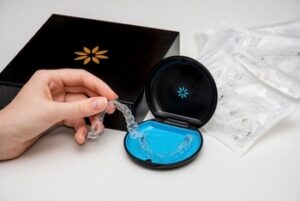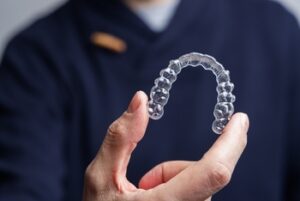Invisalign attachments, also known as aligner buttons or buttons, are small tooth-coloured dots bonded to your teeth during the Invisalign treatment process.
While they may sound intimidating, they are crucial to achieving optimal results with clear aligner treatment.
This article will investigate why Invisalign aligners’ attachments are crucial for some patients and how they work.
What Are Invisalign Attachments?

How Invisalign Attachments Move Your Teeth
Invisalign attachments work with the aligner trays to exert controlled pressure on specific teeth, guiding them into their desired positions.
According to your dentist’s plan, these attachments are strategically placed on the teeth.
Precision And Control
The placement of attachments allows for precise control over tooth movements, addressing even the most intricate alignment issues. Attachments ensure that the aligner trays exert the right force on each tooth by providing extra grip and leverage, facilitating efficient and accurate movement.
Targeted Tooth Movements
Each attachment is an anchor point for the aligner trays, enabling them to target specific teeth that require adjustment. Attachments are crucial in achieving the desired results, whether rotating a tooth, correcting its alignment, or closing gaps.
Aligner Tray Compatibility
Invisalign attachments are designed to seamlessly integrate with the aligner trays, ensuring a snug fit and optimal performance. The trays are custom-made to accommodate the attachments, ensuring they remain securely in place throughout treatment.
Maintenance And Care
While wearing Invisalign attachments, it’s essential to maintain good oral hygiene practices. Regular brushing and flossing help prevent the buildup of plaque and food particles around the attachments, reducing the risk of dental issues such as cavities and gum disease.
Attachment Durability
Invisalign attachments are bonded to the teeth using dental adhesive, ensuring durability throughout treatment. However, it’s essential to handle them with care and avoid excessive pressure or force that could potentially dislodge or damage the attachments.
Signs You Need To Wear Invisalign Attachments
Are you wondering if you’ll need attachments during your Invisalign treatment? Here are some signs to look out for:
- Complex Tooth Movements: If your plan involves extensive tooth movements or rotations, your dentist may recommend attachments to facilitate these adjustments effectively.
- Alignment Issues: Individuals with severe misalignment or bite issues may require attachments to provide the necessary leverage for aligner trays to move the teeth into their correct positions.
- Difficult Tooth Movements: Teeth resistant to movement may benefit from the additional force provided by attachments, ensuring they shift to the desired location as planned.
Benefits Of Invisalign Attachments
While the idea of having attachments bonded to your teeth may seem daunting, they offer several benefits:
- Enhanced Precision: Attachments allow for more precise control over tooth movements, ensuring that each tooth shifts to its correct position according to the treatment plan.

- Faster Treatment: By providing extra force and pressure, attachments can help accelerate the treatment process, potentially shortening the overall duration of your Invisalign journey.
- Discreet Appearance: Although visible up close, attachments are relatively inconspicuous, especially compared to traditional braces. Their tooth-coloured nature ensures that they blend seamlessly with your smile.
- Improved Efficacy: With attachments, your aligner trays can exert the necessary pressure on your teeth, leading to more efficient and effective tooth movement.
What To Expect When Getting Your Invisalign Orthodontic Treatment
Embarking on your Invisalign journey can be an exciting step towards achieving your desired smile.
Here’s a brief overview of what to expect when getting your Invisalign aligners:
Initial Consultation
Your journey begins with a comprehensive consultation with your dentist.
During this appointment, they will assess your dental needs, discuss your treatment goals, and determine whether Invisalign is the right option.
Treatment Planning
If you proceed with Invisalign, your dentist will create a customised plan tailored to your unique dental alignment needs.
This plan will outline the expected duration of treatment and any additional components, such as attachments or buttons.
Fitting And Attachment Bonding
Once your treatment plan is finalised, you’ll undergo a fitting session, during which precise impressions or digital scans of your teeth will be taken.
If attachments are deemed necessary, they will be bonded to specific teeth during this appointment.
Wearing Your Aligners
You’ll receive a series of custom-made aligner trays designed to shift your teeth into the desired positions gradually.
You must wear your aligners for the prescribed amount each day, typically 20 to 22 hours, removing them only for eating, drinking, brushing, and flossing.
Regular Check-Ups
You’ll attend periodic check-up appointments with your dentist throughout your treatment to monitor your progress and make any necessary adjustments to your treatment plan.
Maintenance And Oral Hygiene
Good oral hygiene is crucial during Invisalign treatment, so following your dentist’s instructions is essential.
Brush your teeth after meals and snacks, floss regularly, and clean your Invisalign trays as instructed by your dental provider.
Transitioning Between Aligners
Every few weeks, you’ll switch to a new set of aligner trays, each slightly adjusted to continue your tooth’s gradual movement.
It’s normal to experience mild discomfort or pressure during the initial days of wearing a new set of aligners.
Treatment Completion
Once you’ve completed the prescribed series of aligners and achieved your desired results, your dentist will remove any remaining attachments and discuss post-treatment care, such as wearing retainers to maintain your newly aligned smile.
Follow-Up Care
Even after your active orthodontic treatment ends, attending regular follow-up appointments is essential to ensure the stability of your results and address any concerns that may arise.
Do Invisalign Aligners’ Attachments Leave A Scar Like Traditional Braces?
One common concern among individuals considering Invisalign treatment is whether the attachments leave a noticeable mark on the teeth once removed.
Thankfully, since attachments are bonded using composites that match your tooth colour, they typically do not leave any lasting scars or marks.
Once your treatment ends, your dentist will safely remove the attachments, leaving your teeth in their original state.
Frequently Asked Questions
Do Invisalign attachments hurt?
While you may initially experience discomfort or pressure after getting Invisalign attachments, it is typically minimal and temporary. Your mouth may need time to adjust to the presence of the attachments, but any discomfort should subside within a few days.
How do Invisalign attachments work to straighten teeth?
Invisalign attachments provide extra grip and leverage for the aligner trays, allowing them to exert controlled pressure on specific teeth. This pressure gradually moves the teeth into their desired positions, resulting in a straighter, more aligned smile.
Do Invisalign attachments make the treatment faster?
In some cases, Invisalign attachments can help accelerate the treatment process by providing additional force and leverage for tooth movement. However, the duration of treatment varies depending on individual factors, such as the severity of the misalignment and the treatment plan prescribed by your dentist.
Getting Straight Teeth Faster And More Effectively

While they may take some time to get used to, their treatment efficacy and discreetness benefits make them a valuable addition to the Invisalign journey.
With proper care and adherence to your treatment plan, you can achieve the straight, beautiful smile you’ve always desired with Invisalign attachments.
Contact Balmoral Dental Centre, Bulimba QLD 4171, at 07 3113 9789 to get your clear aligners.
Sources:
Clarius, Aaron. “Invisalign Attachments (Buttons) Explained | NewMouth.” NewMouth, 22 Feb. 2024, www.newmouth.com/orthodontics/treatment/invisalign-attachments.
How Invisalign Works. | Attachments, Buttons and Elastic Bands , Power Ridges. www.animated-teeth.com/dental-braces/a-invisalign-attachments.htm.
Invisalign. How Invisalign Treatment Works | Invisalign. 2 Feb. 2024, www.invisalign.africa/how-invisalign-works.
Karras, Theresa, et al. “Efficacy of Invisalign attachments: A retrospective study.” American Journal of Orthodontics and Dentofacial Orthopedics, vol. 160, no. 2, Aug. 2021, pp. 250–58. https://doi.org/10.1016/j.ajodo.2020.04.028.
Komatsu, Aegis Communications by Jose-Luis Ruiz, Dds, Fagd, Werner J. Finger, Dr. Med. Dent. ,. PhD, Hiromi Sasazaki, Dds, PhD, Masahi, DDS PhD. “Practical Applications: Removal of Invisalign Retention Attachments – a New Minimally Invasive Method.” Copyright ©2024 AEGIS Communications, All Rights Reserved, www.aegisdentalnetwork.com/cced/2009/12/practical-applications-removal-of-invisalign-retention-attachments-a-new-minimally-invasive-method.
Mehta, Shivam, et al. “Staging Orthodontic Aligners for Complex Orthodontic Tooth Movement.” Turkish Journal of Orthodontics, vol. 34, no. 3, Sept. 2021, pp. 202–06. https://doi.org/10.5152/turkjorthod.2021.20116.


